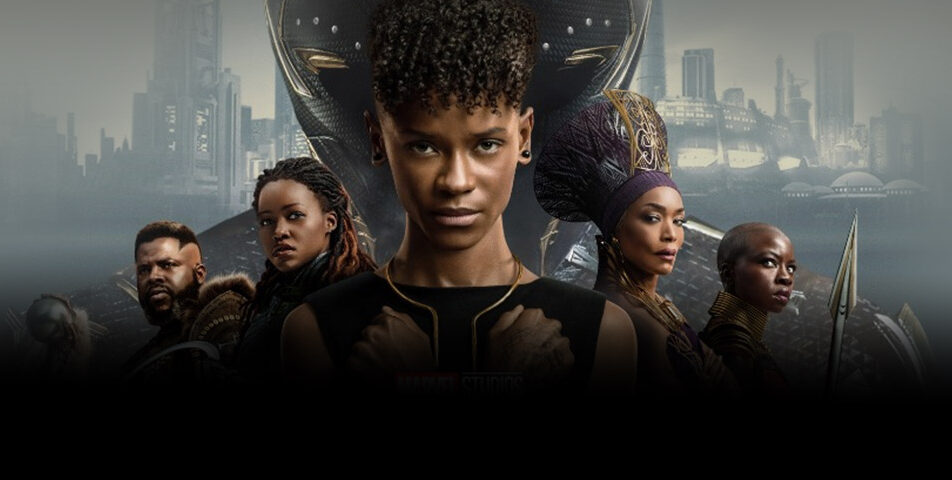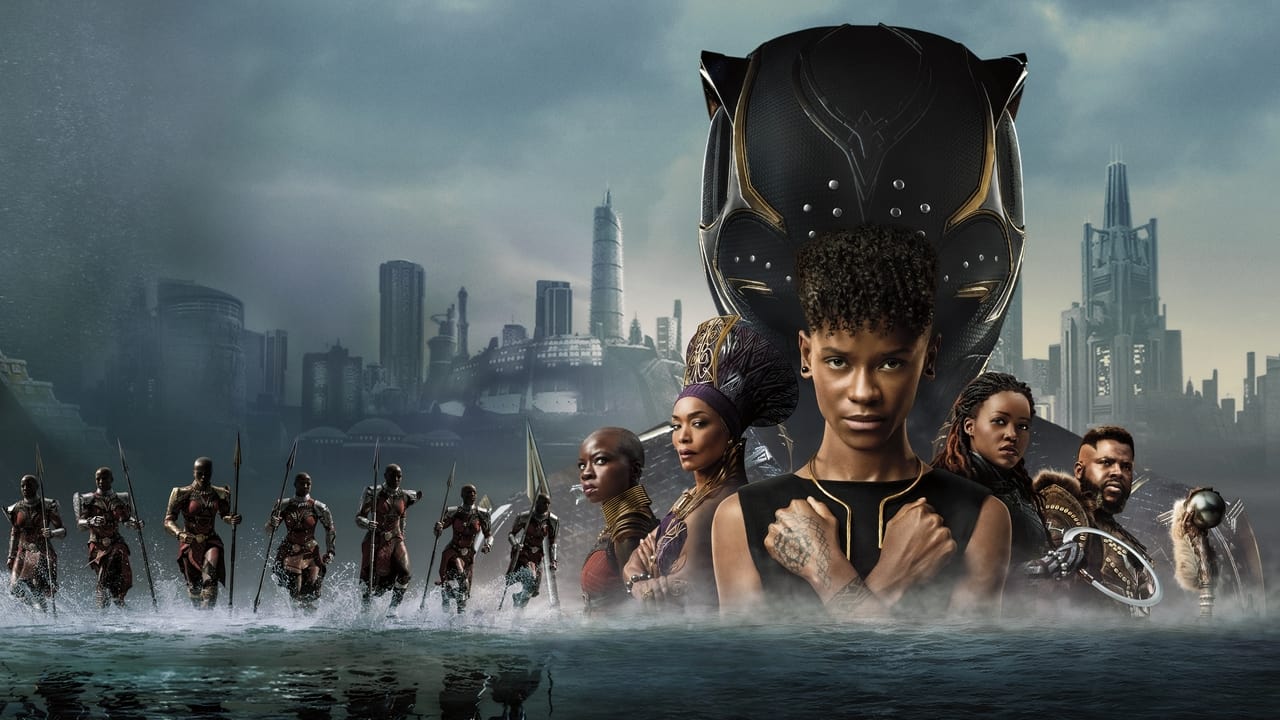1. Introduction
- Brief Overview: “Black Panther: Wakanda Forever” (2022) is the highly anticipated sequel to the groundbreaking Marvel Cinematic Universe film, “Black Panther” (2018). Set after the tragic death of King T’Challa (Chadwick Boseman), it follows the nation of Wakanda as they mourn their beloved leader and face new threats from the hidden underwater kingdom of Talokan.
- Notable Figures: Director Ryan Coogler returned to helm the sequel, paying heartfelt tribute to the legacy of Chadwick Boseman while expanding the world of Wakanda. The cast features returning stars Letitia Wright (Shuri), Lupita Nyong’o (Nakia), Danai Gurira (Okoye), Winston Duke (M’Baku), and Angela Bassett (Queen Ramonda), alongside the introduction of Tenoch Huerta Mejía as Namor, ruler of Talokan.
- Awards: “Black Panther: Wakanda Forever” has garnered significant awards recognition, including an Academy Award (Oscar) win for Angela Bassett (Best Supporting Actress), Golden Globe win for Angela Bassett (Best Supporting Actress), and numerous nominations at the Critics Choice Awards, BAFTA Film Awards, and more.
2. Plot Summary
In the wake of King T’Challa’s passing, Queen Ramonda, Princess Shuri, the Dora Milaje, M’Baku, and the nation of Wakanda grapple with profound grief. They must protect Wakanda from opportunistic world powers seeking to exploit the nation’s vibranium resources following its decision to reveal its true status to the world.
A new threat emerges from the depths of the ocean: Talokan, a powerful underwater civilization led by the charismatic and formidable Namor. Fearing the surface world’s encroachment, Namor demands an alliance with Wakanda against the outside world. When Wakanda refuses, a conflict ensues, forcing the Wakandans to confront loss, legacy, and the difficult choices necessary to forge a new path for their nation.
3. Character Analysis
- Queen Ramonda: Queen of Wakanda, Ramonda exhibits immense strength and resilience, navigating grief while fiercely protecting her nation. Angela Bassett delivers a powerhouse performance.
- Shuri: Princess of Wakanda and T’Challa’s brilliant younger sister, Shuri wrestles with overwhelming grief and the pressure of potentially taking on the mantle of the Black Panther.
- Namor: Ruler of Talokan, Namor is a complex and compelling antagonist with a history of protecting his people by any means necessary. His motivations and methods clash with those of Wakanda.
- Okoye: Leader of the Dora Milaje, Okoye showcases unwavering loyalty and fierce determination, challenged by a crisis of faith and duty.
- M’Baku: The leader of the Jabari Tribe, M’Baku provides a voice of reason and humor while evolving into a more prominent leadership role within Wakanda.
4. Cinematography and Direction
- Cinematography: Autumn Durald Arkapaw’s cinematography beautifully captures the vibrancy of Wakanda, the hidden splendor of Talokan, and the emotional depth of intimate moments.
- Visual Contrast: The film establishes a striking visual contrast between Wakanda’s Afrofuturist aesthetic and the Mayan-inspired world of Talokan.
- Ryan Coogler’s Direction: Coogler skillfully balances grand action sequences with deeply personal themes of grief, family, and the weight of legacy.
5. Music and Soundtrack
- Ludwig Göransson’s Score: The composer returns, creating a score that blends African instrumentation, orchestral soundscapes, and themes from the first film, evoking both the emotional core and the epic scale of the story.
- Thematic Soundtrack: The soundtrack features original songs from global artists including Rihanna, Burna Boy, and Tems, contributing to the film’s immersive atmosphere and amplifying its cultural explorations.
- Integration: The music seamlessly weaves into the narrative, underscoring powerful moments and deepening the emotional resonance.
6. Cultural and Social Impact
- Representation Matters: The first “Black Panther” was a cultural phenomenon, celebrated for its positive representation of African culture and a predominantly Black cast. “Wakanda Forever” continues this legacy while also showcasing the richness of Mesoamerican-inspired cultures through Talokan.
- Themes of Grief and Resilience: The film’s portrayal of how individuals and communities process grief resonates with audiences, especially in light of the real-world loss of Chadwick Boseman.
- Exploration of Colonization: The conflict between Wakanda and Talokan mirrors historical and contemporary issues of colonialism, exploitation of resources, and differing worldviews.
7. Critical Reception and Box Office Performance
- Critical Reception: “Black Panther: Wakanda Forever” received widespread critical acclaim, particularly for its performances, handling of sensitive themes, and stunning visuals. Some critics, however, debated the pacing and length of the film.
- Box Office Success: The film achieved massive commercial success, becoming one of the highest-grossing films of 2022 and demonstrating the enduring power of the Marvel brand.
8. 10 Interesting Facts:
-
Tribute to Chadwick Boseman: The film is imbued with tributes to Chadwick Boseman, seamlessly woven into the narrative and opening Marvel Studios logo.
-
Revamped Black Panther Suit: Shuri designs a new, streamlined Black Panther suit with symbolic design elements honoring her brother.
-
Introduction of Riri Williams/Ironheart: Dominique Thorne debuts as Riri Williams, a brilliant MIT student who develops her own armored suit, foreshadowing her future in the MCU as the superhero Ironheart. (Reference: https://marvelcinematicuniverse.fandom.com/wiki/Riri_Williams)
-
Cultural Consultation for Talokan: Filmmakers consulted with historians and cultural experts to respectfully incorporate elements of Mesoamerican and Mayan cultures into Talokan’s design.
-
Underwater Filming Techniques: While some underwater scenes utilized CGI, several sequences were filmed in giant water tanks with the actors trained to hold their breath.
-
The Meaning of “K’uk’ulkan”: Namor’s title, “K’uk’ulkan,” refers to the Feathered Serpent God of Mayan mythology. (Reference: https://marvelcinematicuniverse.fandom.com/wiki/K%27uk%27ulkan))
-
Lupita Nyong’o’s Fluency in Spanish: Lupita Nyong’o learned Spanish for her role as Nakia, who has been living undercover in a Spanish-speaking country.
-
Julia Louis-Dreyfus Returns: Julia Louis-Dreyfus reprises her role as Contessa Valentina Allegra de Fontaine, hinting at her expanding role within the MCU.
-
Rihanna’s Original Songs: Rihanna returned to music for the first time in years, contributing two original songs to the soundtrack, including the powerful ballad “Lift Me Up.”
-
Mid-Credits Scene Significance: The mid-credits scene introduces a major new character with implications for the future of the MCU. (Note: To avoid spoilers, I won’t directly link to an article explaining the scene)

9. Season-wise Released Date, Genre, Cast, Crew, Public Rating, Reviews, Trivia, Notable Quotes, Awards, Nominations or Achievements, Goofs, Technical Specs
- Release Date: November 11, 2022 (United States)
- Genre: Superhero, Action, Drama, Science Fiction
- Cast: Letitia Wright, Lupita Nyong’o, Danai Gurira, Winston Duke, Angela Bassett, Tenoch Huerta Mejía, Dominique Thorne, Michaela Coel, and more.
- Director: Ryan Coogler
- Public Rating: Generally positive ratings on platforms like IMDb (7.2/10), Rotten Tomatoes (84% fresh), and Metacritic (67/100).
- Awards and Nominations: The film won an Academy Award (Angela Bassett for Best Supporting Actress), a Golden Globe (Angela Bassett for Best Supporting Actress), a Critics Choice Award (Angela Bassett for Best Supporting Actress), and garnered numerous additional nominations. https://www.imdb.com/title/tt9114286/awards]
Notable Quotes
“Show them who we are.” – Queen Ramonda
“The wound is still fresh…” – Shuri
“Only the most broken people can be great leaders.” – Namor
“Vengeance has consumed us. We cannot let it consume our people.” – Queen Ramonda
“Just because something works doesn’t mean it cannot be improved.” – Shuri
Aspect Ratio:
- Filmed: Likely shot with a combination of Panavision anamorphic and digital IMAX cameras.
- Theatrical Release: Primarily released in 2.39:1 (widescreen). However, some IMAX presentations had scenes expanded to a 1.90:1 aspect ratio, offering a taller image.
Image Resolution:
- Filmed: Likely a mix of digital footage at resolutions of 4K, 6K, or even 8K.
- Mastered: A digital intermediate (DI) would have been created, likely at 4K resolution for most versions, and potentially a separate IMAX DI.
Sound Formats:
- Theatrical Release: Dolby Atmos, DTS:X, and standard 5.1 or 7.1 surround sound mixes. Premium theaters might have also offered advanced sound formats like IMAX 12-channel.
Film Formats:
- Shooting: Primarily digital cinematography, potentially with some limited use of 35mm or 65mm film for specific sequences.
- Theatrical Release: Primarily projected in Digital Cinema Package (DCP) format. IMAX theaters would have used their proprietary digital laser projection.
Color:
- Color Grading: ACES (Academy Color Encoding System) workflow likely used.
- Theatrical Presentation: Primarily available in standard color spaces like Rec. 709 or DCI-P3, along with Dolby Vision HDR (High Dynamic Range) in select theaters.
Resources for Finding Specific Details:
- IMDb Technical Specifications: Check the “Technical Specifications” section of the film’s IMDb page for a starting point: https://www.imdb.com/title/tt9114286/technical
- Cinematographer Interviews: Search for interviews with the cinematographer, Autumn Durald Arkapaw, as they often discuss the cameras and technical aspects of the production.
- Film Industry Websites: Websites like the American Cinematographer (https://ascmag.com/) sometimes publish detailed technical breakdowns of major films.
Important Note: Some specific technical details might not be made public, especially those that pertain to proprietary technology developed by Marvel Studios or their visual effects partners.
10. Conclusion
“Black Panther: Wakanda Forever” is both a poignant tribute to Chadwick Boseman and a powerful continuation of the Black Panther legacy. The film deftly balances action with heartfelt emotion, exploring themes of loss, resilience, and the question of leadership in the face of immense challenges. While its runtime might feel long to some, its performances, visual impact, and cultural significance make it a compelling and important chapter in the Marvel Cinematic Universe.
11. Recommendation
- Perfect for fans of: The Marvel Cinematic Universe, the original “Black Panther,” socially conscious superhero films, explorations of diverse cultures.
- If you like…then…: For its Afrofuturist aesthetic and themes, you might also enjoy other Marvel films, “Dune,” or the series “Lovecraft Country.”
- Where to watch: The film is available for streaming on Disney+.

